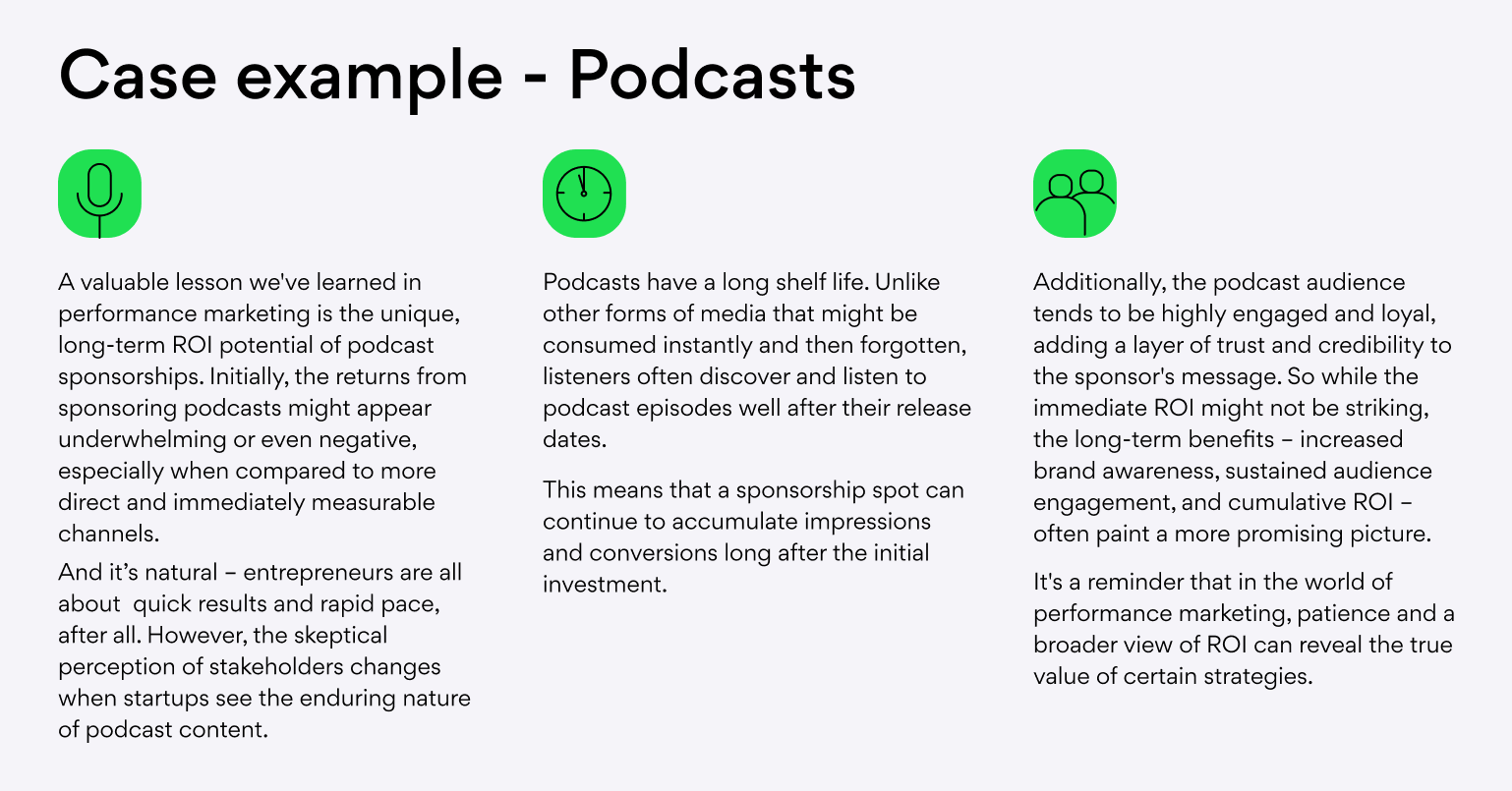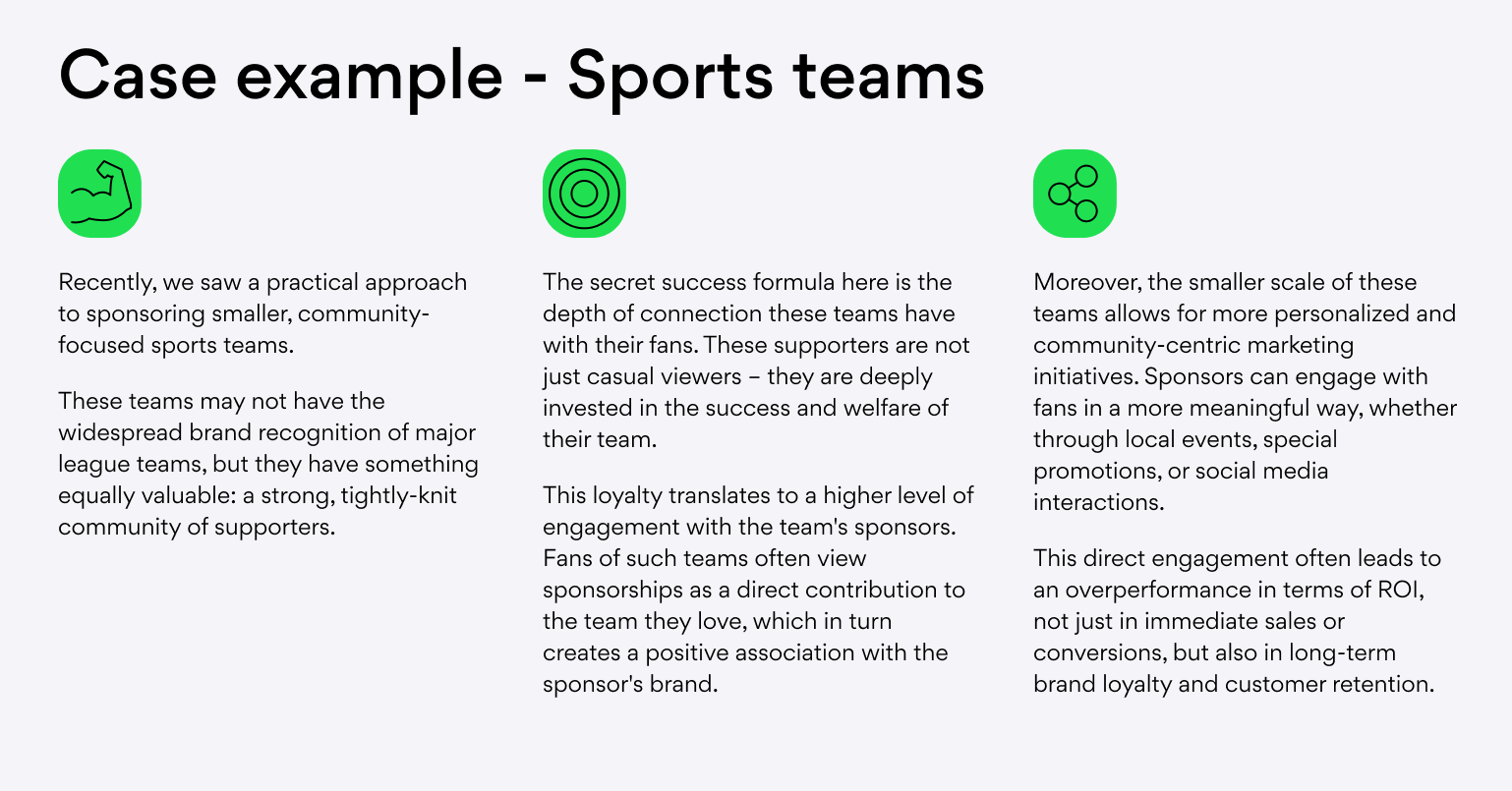
Getting the most out of your marketing: Performance marketing for your early-stage startup
April 26, 2024•10 mins read
If you are a founder or marketer of a startup, especially at an early stage, you know that every dollar counts. As a CMO who has navigated these stormy waters, I’ve learned that performance marketing is not just a strategy, it’s a lifeline. It’s the art of ensuring that every investment made in marketing is not only outstanding and attention-grabbing but also brings measurable returns. In this article, I’ll try to guide you through the essentials of performance marketing, offering some insights that could help your early-stage startup thrive even with limited resources.
The basics of performance marketing
To put it plainly, performance marketing is about measurable outcomes. When we started, our mantra was simple: For every dollar spent, earn at least $1.15 back. This approach encompasses all media channels and marketing initiatives where we can numerically evaluate the ratio of expenses and return. The key? Flexibility in adapting to different stages, channels, and focuses, whether it’s growth, quality, or higher profit margins.
Unlike traditional marketing, which involves upfront payments for advertising space or airtime, performance marketing is rooted in the digital realm. Here, advertisers pay based on ad performance, such as clicks, conversions, or sales. This model provides immediate and measurable results, perfect for situations where you have to justify every penny spent.
Startups often operate under resource constraints. Performance marketing platforms like Google Ads and social ads allow for efficient audience targeting and budget allocation. These platforms enable startups to calculate key metrics such as cost per acquisition (CPA), average order value (AOV), return on ad spend (ROAS), and lifetime value (LTV), essential for understanding the health of your investments.
Multiple roles in performance marketing
Initially, a few team members might handle multiple roles. However, as your startup grows, performance marketing can expand into specialized teams. Most often they are formed similar to this:
- Partnerships: Focuses on affiliate relationships, influencers, and growth marketing.
- Pay-per-click (PPC) advertising: Optimizes ads across search engines and other channels for best results at the lowest price.
- Mobile app marketing: Enhances revenue from mobile apps through various advertising channels and app marketplace optimizations.
- Search engine optimization (SEO): Increases website revenue from organic traffic via keyword research, content optimization, and backlink building.
- User retention: Manages customer relationships through email and in-app notifications, onboarding, and value communication.
Of course, other teams might be included in the list. Each team tracks specific parameters like cost, CPA, ROAS, AOV, and LTV to understand how budgets translate into results.
Setting clear goals and expectations
When you start to dip your toes in performance marketing, the first priority should be to set clear goals. For startups and all businesses, it’s important to align marketing goals with broader company objectives. Typically, it’s best to limit these to no more than five overarching goals. From there, we develop specific, measurable key performance indicators (KPIs) and objectives and key results (OKRs) for the marketing campaigns. These serve as a roadmap, ensuring every marketing effort directly contributes to the company’s vision. In my opinion, cross-team OKR goals are particularly beneficial because they help encourage collaboration and coordination across different marketing teams.
Determining an ideal ROI for startups can be challenging, and it varies based on industry, market conditions, and the startup’s growth stage. However, a fundamental rule is to aim for positive ROI, where the returns significantly exceed the marketing spend. It would help if you kept reminding yourself that performance marketing is not about using one channel exclusively but finding the right mix that yields the best results. In my experience, I found that a lot of performance marketing is about experimentation and adaptability.

Channels and platforms
You will quickly learn that not all channels feel like they are created equal for different startups. The effectiveness of digital channels — be it social media, search engines, email marketing, or content platforms — depends largely on where your target audience spends their time and how they prefer to engage. It’s a blend of science and, well, art to choose the right platforms for your startup.
Choosing the right platform is a critical decision that directly influences both cost and potential ROI. Factors such as the nature of your product/service, the demographics of your target audience, and the typical customer journey within your industry play a crucial role. It’s about striking a balance between reaching your target audience effectively and managing costs efficiently.
Search engine marketing (SEM), for instance, is the frontline of your digital visibility. It’s where you can bid on keywords to appear at the top of search results. For example, if you are a new healthtech brand, you could aim to appear when someone searches for “best longevity supplements.” It’s effective for quickly driving traffic and conversions, and capturing the attention of users who are actively searching for your product or service.
Affiliate marketing is a powerhouse in performance marketing. By partnering with affiliates, you can extend your marketing reach without upfront costs. It’s like having an army of promoters, only paying commissions when sales are made. For example, a tech startup could partner with bloggers, who then refer customers to their software, creating a win-win scenario.
Influencer marketing is all about leveraging the sway of popular figures. A startup, say in the health industry, could partner with fitness influencers, tapping into their followers for brand promotion. The key is to find the right ones. That means identifying individuals or organizations whose audiences align closely with your target market. These partnerships can be a goldmine for startups, especially when resources are tight. Affiliates and influencers can amplify your brand’s message, reaching corners of the market that you might not be able to on your own. But just like any other aspect of performance marketing, it’s important to track the effectiveness of these collaborations. This can be done through affiliate tracking software or by using unique promo codes and UTM parameters to track the source of traffic and conversions.

Email marketing might seem a bit old school, but its effectiveness is unquestioned. It’s about nurturing relationships with your audience. Your startup could send personalized product recommendations based on previous purchases, turning one-time buyers into loyal customers.
Such marketing often serves as the backbone for other marketing efforts. It’s not directly a paid channel, but it’s invaluable. For example, a fintech startup could create informative blog posts about personal finance, boosting SEO and providing engaging content for their social media channels.
Display advertising and video advertising are about capturing attention in different ways. While display ads, like those on the Google Display Network, are great for retargeting and keeping your brand top-of-mind, video ads on platforms like YouTube could help you tell your brand’s story, engage with customers, and leave a lasting impression.
Last, but not least, if you are an early-stage startup, mobile marketing is becoming increasingly important in our smartphone-centric world. Its initiatives can range from SMS promotions to push notifications from apps.
Performance marketing trends in 2024
It’s no surprise that just like all other digital marketing methods, performance marketing continues to evolve and search for new ways to engage with customers. You and your startup need to stay ahead of current trends. For example, finding ways to utilize AI or machine learning in automating and optimizing your digital campaigns. Additionally, you need to be mindful of regulatory changes, especially concerning privacy and data usage. Here are a few trends that are quickly gaining traction in performance marketers community:
- Short-form video content dominance: Platforms like TikTok, Instagram Reels, and YouTube Shorts continue to be incredibly popular. Short-form videos have proven to be highly effective in engaging audiences, given the often short attention spans of online users. Brands are leveraging these platforms not just for their reach, but for their ability to create deeper connections with potential customers.
- Content reflecting brand values: Now, more than ever, consumers are looking for brands whose values align with their own. This trend is pushing marketers to create content that not only promotes their products or services but also showcases their brand’s stance on various social and environmental issues.
- Boom of the micro-influencers: Brands are not only collaborating with celebrities but are also turning their focus to micro-influencers. These influencers might have smaller followings, but they often boast higher engagement rates and can be more cost-effective.
- Rise of AI and automation: AI is being utilized for various purposes, including content creation, customer engagement, and predictive analytics. This technology streamlines processes, often reducing repetitive tasks to allow marketers to focus on strategic aspects of their campaigns.
- Balancing brand and performance spending: Marketers understand they must walk a thin line between investing in long-term brand development and short-term performance marketing. Over-focusing on performance marketing without building a long-term brand vision could hurt the path to sustainable growth.
Challenges and limitations in performance marketing
Every marketing strategy comes with its own set of challenges and limitations, and performance marketing is no exception. When you begin your journey with performance marketing, it would help if you kept following challenges in mind:
- Rapid Market Changes: You, as a performance marketer, should be ready to pivot without hesitation if some approach proves to be ineffective. What works today might not work tomorrow, and you need to be agile enough to adapt quickly to these changes, even if it means saying goodbye to an initiative that up until now showed a great promise.
- Finding the Right Mix of Channels: With so many channels available, it can be challenging to determine the best mix for your startup. Be prepared to do continuous testing and analysis to find out where your efforts are most effective.
- Data Privacy and Regulatory Challenges: With increasing concerns over data privacy and regulations like GDPR and CCPA, you need to be vigilant and extra cautious about how you collect and use customer data.
- Ad Fatigue and Consumer Skepticism: In an era where consumers are bombarded with ads, there’s a real risk of ad fatigue. Moreover, growing skepticism about advertising means that you need to aim to be authentic and value-driven in your messaging.
- Dependency on Digital Platforms: Over-reliance on a single platform can be risky, especially if algorithm changes or policy updates occur. Diversification is key to mitigating this risk.
- Building Brand Trust: While performance marketing is effective for immediate results, building long-term brand trust and loyalty takes time. This is where the interplay of brand marketing becomes vital.
Brand marketing to the rescue
The challenges and limitations of performance marketing highlight the importance of simultaneously building brand marketing initiatives. Brand marketing helps in establishing a deeper connection with the audience, fostering trust and loyalty over time. It’s about telling your brand’s story, sharing its values, and creating emotional resonance with your audience.
While performance marketing focuses on immediate ROI and conversions, brand marketing plays the long game, contributing to sustainable growth. This balance ensures that while you’re driving sales and conversions in the short term, you’re also building a loyal customer base that will stand the test of time. But it’s a topic for another article.
Read more like this
-
Marketing
October 4, 2023•6 mins read
When to imitate and when to innovate: Marketing for your early-stage startup
-
Marketing
August 25, 2022•5 mins read
3 super-practical tips startups need to know from an influencer marketing expert
-
Marketing
August 9, 2022•6 mins read
Growing globally? A marketing expert explains why influencer marketing is the perfect channel
-
Marketing
July 8, 2022•5 mins read
Entering new markets? Here’s the localization checklist and expert tips you need







